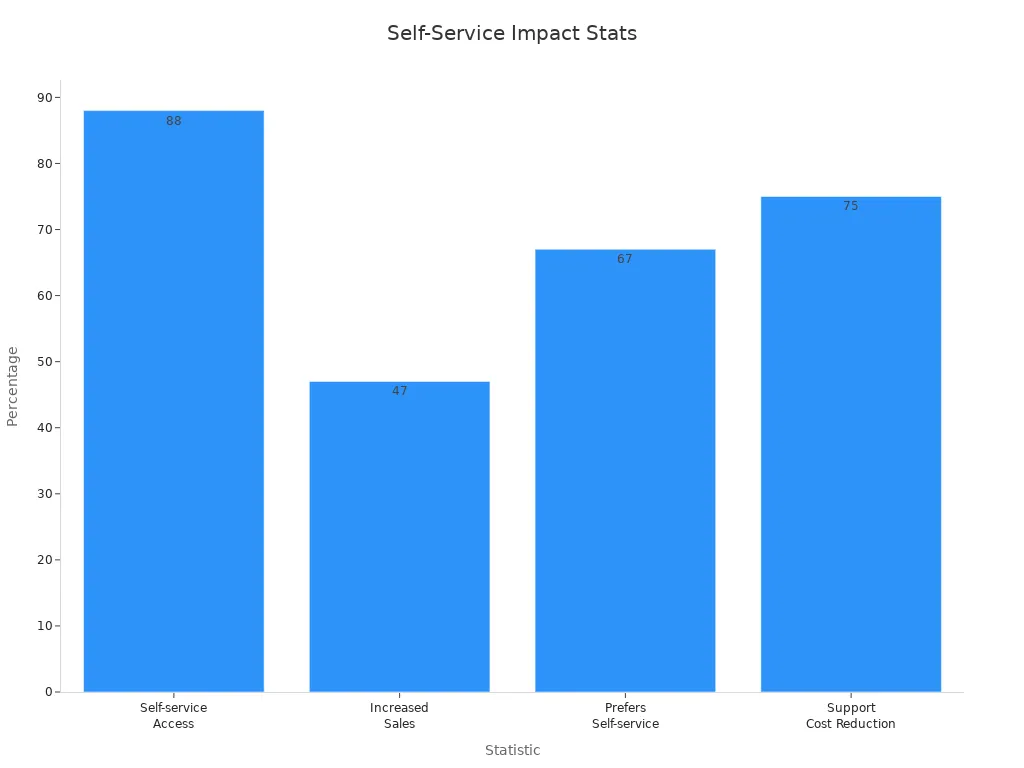What Defines a Good Customer Effort Score for Businesses Today

A good customer effort score (CES) reflects how easily your customers can interact with your business to resolve their issues or complete their goals. The less effort they expend, the better the experience and the higher your CES. Research shows that 94% of customers who encounter effortless experiences are likely to repurchase, while 96% of those facing high effort are likely to churn. This makes CES a powerful predictor of loyalty—1.8 times more effective than traditional metrics like CSAT.
Focusing on CES helps you identify and eliminate pain points in the customer journey. Simplifying processes improves satisfaction, reduces churn, and drives positive word-of-mouth. However, benchmarks for what is a good customer effort score can vary by industry. For example, e-commerce businesses may prioritize seamless checkout, while SaaS companies focus on intuitive onboarding. By understanding these differences, you can tailor your strategy to achieve better results. Additionally, tools like Sobot can assist in measuring and improving your CES, ensuring that your customers have the best possible experience.
What Is a Good Customer Effort Score?
Definition of a good CES
A good customer effort score reflects how easily your customers can achieve their goals when interacting with your business. On a 7-point scale, scores between 5 and 6 indicate that your customers find the process smooth and hassle-free. Scores below 5 suggest that customers face challenges, which can lead to dissatisfaction and churn. Consistently achieving scores below this threshold signals that your customer experience needs improvement.
When you aim for a good CES, you prioritize reducing the effort required for customers to resolve issues or complete tasks. This focus not only enhances satisfaction but also builds loyalty. For example, if your e-commerce platform simplifies checkout with intuitive design and fast payment options, customers are more likely to return.
Tip: Tools like Sobot can help you measure CES effectively and identify areas for improvement. By streamlining customer interactions, you can ensure a seamless experience that drives satisfaction and retention.
Common standards for evaluating CES
Businesses use CES surveys to measure how easy it is for customers to interact with their services. These surveys typically ask a single question: "How easy was it to resolve your issue?" Responses are rated on a scale from 1 (very difficult) to 7 (very easy).
CES is often evaluated alongside other metrics like CSAT and NPS to provide a comprehensive view of customer satisfaction and loyalty. Here's a comparison of these metrics:
| Metric | Description | Importance |
|---|---|---|
| Customer Effort Score (CES) | Measures ease of customer interaction and resolution | 40% more accurate at predicting customer loyalty than customer satisfaction |
| Customer Satisfaction (CSAT) | Measures overall satisfaction with a specific interaction | Provides insight into customer happiness |
| Net Promoter Score (NPS) | Gauges customer loyalty by likelihood to recommend | Indicates overall brand loyalty and advocacy |
Tracking CES alongside operational metrics allows you to pinpoint pain points in the customer journey. For instance, if your CES survey reveals that customers struggle with navigating your website, you can implement self-service tools to simplify the process.
Why a good CES matters for businesses
A good CES is essential for fostering customer loyalty and driving business success. When customers find it easy to interact with your brand, they are more likely to return and recommend your services. According to Harvard Business Review, reducing customer effort is more effective at building loyalty than trying to delight customers.
Improving CES directly impacts your bottom line. By identifying and addressing areas where customers face difficulties, you enhance the overall customer experience. For example, a SaaS company that simplifies onboarding through clear instructions and responsive support can achieve higher retention rates.
Note: Sobot’s AI-driven solutions can help you reduce customer effort by automating repetitive tasks and providing instant support. These tools ensure fast resolutions, making your customers’ experience effortless and enjoyable.
Understanding the Customer Effort Score Survey

What is a Customer Effort Score survey?
A customer effort score survey measures how easy it is for your customers to interact with your business. It focuses on the effort required to resolve issues or complete tasks. The survey typically asks customers to rate statements like, "[Your company] made it easy for me to handle my issue," using a scale from 1 to 5 or 1 to 7. This simple design ensures clarity and encourages participation.
You can send these surveys immediately after customer actions, such as completing a purchase or contacting support. Real-time feedback captures accurate impressions and helps you identify areas for improvement. For example, an e-commerce business might use a pop-up survey after checkout, while a SaaS company could send it via email after onboarding.
Tip: Keep your survey concise and focused. A single question with an optional open-ended follow-up can provide both quantitative and qualitative insights.
How CES surveys are conducted
Conducting a customer effort score survey involves three key steps:
- Designing the survey: Create a short questionnaire with clear, straightforward questions. Focus on measuring customer effort and avoid unnecessary complexity.
- Collecting responses: Distribute the survey immediately after customer interactions. Use channels like email, website pop-ups, or in-app notifications to maximize response rates.
- Analyzing the data: Calculate the CES by averaging the responses. Segment the results by interaction type to identify trends and actionable insights.
Timing plays a crucial role in the process. Sending surveys right after interactions ensures that feedback reflects the customer’s most recent experience. Additionally, analyzing response patterns can help you uncover specific pain points, such as navigation issues on your website or delays in customer service.
Interpreting CES survey results
Interpreting the results of a customer effort score survey requires a structured approach. Start by calculating the average CES score. For example, if you use a 1-10 scale, sum all the scores and divide by the number of responses. Alternatively, you can use visual scales like happy/unhappy faces to gauge customer sentiment.
To gain deeper insights, analyze the feedback to identify effort hotspots. Look for patterns across different touchpoints, such as checkout processes or support interactions. Categorize issues into areas like process friction, communication gaps, or lack of empowerment. Prioritize fixes based on their impact on customer experience.
Example: If customers frequently mention difficulty navigating your website, consider simplifying the layout or adding self-service tools. Small changes can significantly improve your CES and overall customer satisfaction.
Factors That Influence a Good Customer Effort Score
The role of customer service responsiveness
Customer service responsiveness plays a critical role in shaping your customer effort score (CES). When customers receive quick and efficient support, their experience improves significantly. Delays or unresolved issues, on the other hand, increase frustration and effort. Research highlights that low-effort interactions lead to a 12% increase in retention and a 14% boost in repeat purchases.
For example, implementing a QR code-based digital return system can simplify the process for your customers. This approach not only improved CES to 5.9 but also resulted in higher customer satisfaction and loyalty. Faster resolutions mean less time spent on problems and more time for browsing or completing purchases.
| Evidence Description | Impact on CES | Additional Insight |
|---|---|---|
| QR code-based digital return system improved CES to 5.9 | 14% increase in repeat purchases | Reducing effort directly impacts revenue |
| Low effort ratings lead to 12% increase in retention | Stronger predictor of loyalty | 63% more likely to make additional purchases within 30 days |
| 42% less time resolving issues with low effort scores | Higher customer satisfaction and loyalty | Less time spent on issues means more time for purchases |
By prioritizing responsiveness, you can meet customer expectations and create a seamless customer journey.
Impact of technology and self-service tools
Technology and self-service tools are game-changers for improving CES. Customers increasingly prefer self-service options, with 88% wanting access to these tools when shopping online. Features like FAQs, chatbots, and how-to guides empower customers to resolve issues independently, reducing their effort.
Businesses that adopt self-service solutions often see tangible benefits. For instance, 47% of companies report increased sales after implementing these tools. Additionally, self-service can cut support costs by up to 75%, allowing you to allocate resources more effectively.

The global self-service technology market is expected to grow at a 14% CAGR from 2023 to 2030, reflecting its rising importance. By leveraging these tools, you can enhance the customer experience while meeting modern expectations.
Importance of clear communication and fast resolutions
Clear communication and fast resolutions are essential factors influencing CES. When customers understand the steps to resolve their issues, they feel more confident and satisfied. Complicated instructions or vague responses, however, can lead to confusion and increased effort.
Every interaction should focus on simplicity. For example, providing step-by-step guides or visual aids can make processes easier to follow. Fast resolutions also play a key role. Customers value businesses that address their concerns promptly, as it demonstrates respect for their time.
Simplicity in communication and speed in problem-solving not only improve CES but also strengthen customer loyalty. By addressing these areas, you can create a smoother customer journey and exceed customer expectations.
Industry-Specific Benchmarks for Customer Effort Score
CES benchmarks in e-commerce
In e-commerce, a good customer effort score reflects how easily customers can complete tasks like browsing, purchasing, or returning items. Benchmarks often focus on streamlining processes such as checkout and delivery tracking. For example, platforms that offer one-click purchasing or automated return systems tend to achieve higher CES ratings.
E-commerce businesses prioritize simplicity and speed. Customers expect intuitive navigation, fast payment options, and clear communication about shipping. A CES survey conducted after checkout can reveal whether your processes meet these expectations. If customers rate their experience as "very easy," you’re on track. However, scores below the industry average signal areas for improvement.
Tip: Use self-service tools like FAQs and chatbots to reduce effort during common interactions. These tools empower customers to resolve issues independently, boosting satisfaction and CES.
CES benchmarks in call centers and customer support
Call centers and customer support functions rely heavily on CES to measure the ease of issue resolution. Low-effort interactions not only improve customer satisfaction but also reduce operational costs. Research shows that 94% of customers who experience effortless support intend to repurchase, while low-effort interactions cost 37% less than high-effort ones.
| Evidence | Description |
|---|---|
| 94% of customers with low-effort interactions intend to repurchase | Highlights the importance of low effort in driving repeat business. |
| Low-effort interaction costs 37% less than high-effort interaction | Emphasizes the financial benefits of reducing customer effort. |
To achieve a good CES, focus on responsiveness and clarity. Customers value quick resolutions and straightforward communication. For instance, integrating live chat or AI-driven support can help reduce effort by providing instant answers. Additionally, training your team to prioritize customer ease ensures consistent results across all interactions.
CES benchmarks in SaaS and subscription-based businesses
SaaS and subscription-based businesses often measure CES during onboarding and product usage. A good CES indicates that customers find your software intuitive and easy to use. Benchmarks in this industry emphasize usability and seamless integration.
- CES surveys typically consist of a single question about ease of issue resolution, rated on a scale from "very difficult" to "very easy."
- Survey platforms automate CES distribution via email or after customer support interactions.
- Integrating survey tools with CRM systems helps collect CES data alongside customer information for better analysis.
- Specialized feedback platforms provide advanced reporting and analytics for CES data.
- Point-of-service CES surveys can be integrated into support interactions, such as after live chats or within ticketing systems.
- In-app survey tools allow real-time CES feedback collection directly within the SaaS product.
By leveraging these tools, you can identify pain points and improve usability. For example, simplifying onboarding with step-by-step guides or video tutorials can significantly enhance CES. Customers who find your product easy to navigate are more likely to renew subscriptions and recommend your services.
Actionable Strategies to Achieve a Good Customer Effort Score

Streamlining customer service processes
Streamlining your customer service processes is one of the most effective strategies to improve CES. Simplifying workflows reduces the time and effort customers spend resolving their issues. When you focus on efficiency, you not only enhance the customer experience but also improve key business metrics.
For example, prioritizing high-impact issues can significantly reduce customer effort. Start by identifying the most common pain points in your service processes. Then, redesign workflows that consistently generate high effort scores. Incremental improvements, such as automating repetitive tasks, can also make a big difference.
| Metric | Description |
|---|---|
| Reduce the product return rate | Lowering this rate increases the likelihood of repeat purchases from existing customers. |
| Improve the rate of resolution | A higher resolution rate directly correlates with customer satisfaction, especially in initial interactions. |
| Increase the Customer Lifetime Value | Higher lifetime value signifies better retention of customers, which is more cost-effective than acquiring new ones. |
| Improve customer satisfaction levels | Higher satisfaction levels correlate with customer loyalty and retention. |
Streamlining processes also helps reduce the time between purchases, which indicates higher customer satisfaction. By focusing on these areas, you can create a seamless experience that encourages loyalty and repeat business.
Tip: Use CES feedback to identify bottlenecks in your service processes. Addressing these issues first will have the greatest impact on reducing customer effort.
Leveraging AI and automation for efficiency
AI and automation have revolutionized how businesses reduce customer effort. These technologies allow you to handle repetitive tasks efficiently, freeing up your team to focus on more complex issues. For example, AI-powered platforms can automate routine actions like order tracking or appointment scheduling, making the process effortless for customers.
AI also enhances support channels by providing real-time assistance to your agents. Features like sentiment analysis and suggested responses help agents resolve issues faster and more accurately. Additionally, AI-driven self-service tools empower customers to find answers independently. This reduces the need for human intervention and improves the overall customer experience.
- AI-driven self-service solutions escalate issues to human agents when necessary, ensuring a smooth transition and reducing frustration.
- Knowledge retrieval by AI minimizes the time agents spend searching for answers, allowing them to focus on resolving customer concerns.
- Automation of routine tasks enables agents to concentrate on complex problems, improving productivity and customer satisfaction.
By leveraging AI, you can enhance support channels and improve CES. These tools not only reduce customer effort but also provide valuable insights into performance metrics. For instance, AI-powered platforms can monitor CES trends, helping you identify areas for improvement.
Callout: Businesses that adopt AI and automation often see higher customer satisfaction and loyalty. These tools make it easier for customers to interact with your brand, creating a positive and lasting impression.
Training teams to prioritize customer ease
Your team plays a crucial role in achieving a good customer effort score. Training them to prioritize customer ease ensures consistent and high-quality interactions. When your staff understands the importance of reducing customer effort, they can tailor their approach to meet customer needs effectively.
Start by educating your team on the principles of a low-effort customer experience. Teach them to communicate clearly and resolve issues quickly. Role-playing scenarios based on CES feedback can help them practice handling common challenges. For example, if customers frequently struggle with a specific process, your team can learn how to guide them through it step by step.
Encourage your team to focus on empathy and active listening. Customers appreciate when their concerns are acknowledged and addressed with care. By fostering a customer-first mindset, you can build trust and loyalty.
Note: Regularly review CES survey results with your team. Use this data to identify training opportunities and celebrate successes. A well-trained team is essential for delivering an effortless customer experience.
Using customer feedback to drive improvements
Customer feedback serves as a powerful tool for refining your customer effort score (CES). By listening to your customers, you can uncover hidden pain points and identify opportunities to make their experiences smoother. Feedback provides actionable insights that help you create a more effortless journey for your customers.
Start by analyzing the feedback you collect. Look for recurring themes or issues that customers mention frequently. For example, if customers often report difficulty navigating your website, this signals a need for improvement in your site’s design. Use this information to prioritize changes that will have the greatest impact on reducing effort.
Once you identify areas for improvement, create a clear action plan. Regularly track the progress of your initiatives to ensure they stay on course. After implementing changes, measure their impact by collecting feedback again. This allows you to see whether your efforts have improved your CES and overall customer satisfaction. If the results fall short of expectations, refine your approach and try again. Iteration is key to achieving lasting improvements.
Tip: Establish ongoing feedback loops to maintain a continuous flow of insights. This proactive approach helps you spot emerging issues before they escalate, keeping your CES high and your customers happy.
Customer feedback also enables you to make data-driven decisions. It validates or challenges your assumptions about what your customers need. For instance, you might believe that faster response times are the top priority, but feedback could reveal that customers value clear communication even more. By aligning your strategies with actual customer preferences, you can focus your efforts where they matter most.
To maximize the benefits of feedback, integrate it into every stage of your customer journey. Use surveys, reviews, and direct interactions to gather insights. Whether it’s through post-purchase surveys or follow-ups after support interactions, every piece of feedback adds value. This holistic approach ensures that your CES improvements are not just reactive but also proactive.
By leveraging customer feedback effectively, you can transform your business into one that prioritizes ease and satisfaction. Customers will notice the difference, and their loyalty will reflect it.
Achieving a good customer effort score is essential for creating a seamless experience that keeps customers coming back. When you reduce the effort required to interact with your business, you improve customer satisfaction and build loyalty. CES serves as a reliable metric to identify pain points and refine processes, ensuring your customers feel valued and supported.
The benefits of focusing on CES extend beyond satisfaction. Companies with superior customer experiences can achieve twice the revenue growth of their peers, while retaining 74% of customers for an additional year. A 5% increase in retention can boost profits by up to 95%, and high satisfaction levels can reduce service costs by 20%. These metrics highlight how improving CES drives both loyalty and business growth.
| Metric | Impact | Source |
|---|---|---|
| Revenue Growth | Companies with superior CX can achieve 2× revenue growth compared to peers. | Bain & Company |
| Customer Retention | Improving CSAT can help retain 74% of customers for an additional year. | Harvard Business Review |
| Profitability | A 5% increase in retention can boost profits by 25% to 95%. | Harvard Business School |
| Cost Savings | High customer satisfaction can reduce service costs by up to 20%. | Various Studies |
| Brand Loyalty | High NPS correlates with lower churn and better subscriber growth. | Bain & Company |
By adopting CES as a key performance metric, you can continuously improve customer experience and satisfaction. This proactive approach not only strengthens your relationship with customers but also positions your business for long-term success.
FAQ
What is a customer effort score?
A customer effort score measures how easy it is for your customers to interact with your business. It focuses on the effort required to resolve issues or complete tasks. A higher score indicates a smoother experience, which leads to better satisfaction and loyalty.
How can you improve your CES?
You can improve your CES by simplifying processes, using self-service tools, and training your team to prioritize customer ease. Focus on reducing friction in customer interactions and resolving issues quickly. Regularly collect feedback to identify pain points and make necessary adjustments.
Why is CES important for your business?
CES helps you understand how much effort your customers expend when interacting with your business. A good score indicates a seamless experience, which boosts satisfaction and loyalty. It also helps you identify areas for improvement, ensuring long-term success.
How do you calculate a customer effort score?
You calculate a customer effort score by averaging responses from a survey. Customers rate their experience on a scale (e.g., 1 to 7). Add all the scores and divide by the number of responses to get the average CES.
What industries benefit most from CES?
Industries like e-commerce, SaaS, and customer support benefit greatly from CES. These sectors rely on smooth interactions to retain customers. A good CES ensures that processes like checkout, onboarding, or issue resolution are effortless, leading to higher satisfaction and loyalty.
See Also
Comparative Analysis of Leading Customer Feedback Tools
Best 10 Customer Insight Software Solutions for 2024
2024's Leading Customer Support Software: Top 10 Picks